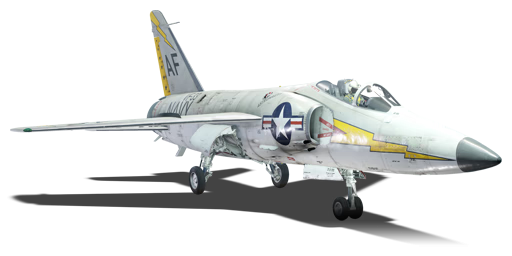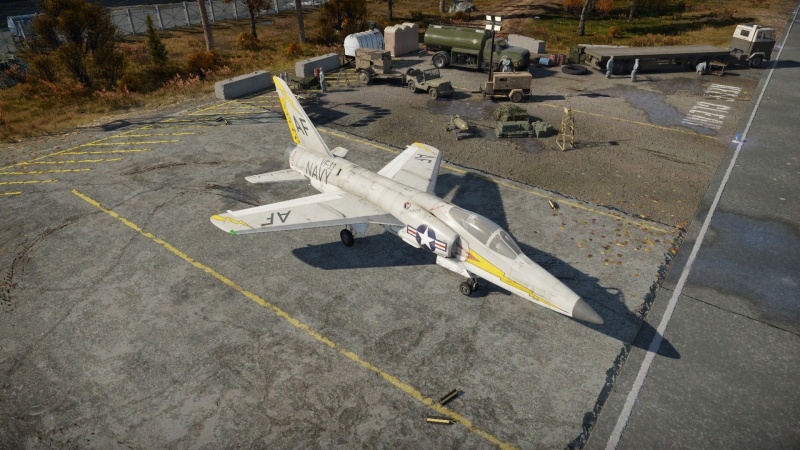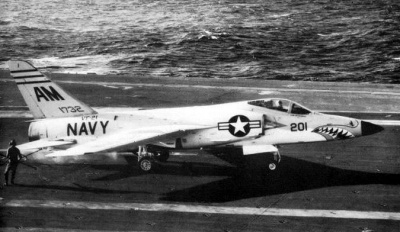F11F-1
Contents
Description
The F11F-1 Tiger is a gift rank VI American jet fighter with a battle rating of 9.0 (AB/RB/SB). It was introduced during Update "Starfighters" as a reward for the 2020 Operation S.U.M.M.E.R. event.
General info
Flight performance
The F11F-1 Tiger is a supersonic carrier based jet fighter, it is equipped with the Allison J65-W-18 engine. The plane is able to reach Mach 1 speed in level speed making it one of the fastest planes at its battle rating, but getting it past that speed will require it to start diving. Because of the very high structural speed limit it basically can dive with an afterburner at any angle and the player will only have to worry about very high speed (past mach 1) compression. The acceleration is decent for this type of plane, while other United States supersonic jet fighters like a F-100 or F3H are better at this aspect, the other planes that it will meet at similar battle rating will struggle to keep up with it, for example the MiG-17AS, Shenyang F-5 or the German CL-13B Mk.6 and it will happen especially when the Tiger is flying with 20 or less minutes of fuel. The F11F is very good at climbing, its climb rate is up to ~65 m/s at sea level when the plane is fully loaded with no additional armament under its wings and increases to 75 m/s with 20 minutes of fuel. While the engine in this plane does not tend to overheat the player should still be cautious about flying at full power, with afterburner its fuel consumption is enormous, with full fuel tanks it can use it for about 20 minutes at low altitude and 6 minutes with 20 minutes of fuel.
The manoeuvrability depends a lot on its speed, when the plane is flying at 500 km/h IAS or below it gets really bad, every subsonic fighter will be able to outturn the F11F, but gets better once it reaches 700 km/h and above. It does not lock up even when close to Mach 1 speeds and it can easily lose a wing after pulling too much G, mainly because of low allowed G limits. The Tiger basically is very bad at low and medium speed dogfighting and capable only of hit and run tactics and others that rely on very high speed performance. Its roll rate is as good as in the F-86 series, it can reach up to ~250 degrees per second at its optimal speed, that can make it very hard for the enemy to land some hits on it and make it easier to force the enemy to overshot. The airbrake on this plane is effective only above a certain speed and gets not so effective during landing and makes the plane very hard to slow down in a straight line flight, especially because it can not be used when the landing gear is extended. Using its flaps will also not really help that much in that situation and since it can be deployed in one position, the one for landing, its usefulness in combat situations is questionable.
In simulator battles it can fly at much higher angles than with the enabled instructor, making it more capable at high angle attacks and snapshots, but it can also lead to breaking a wing because of that when the speed is too high. The other downside of doing that is even further decreased turning energy retention which is already quite mediocre at low and medium speed.
| Characteristics | Max Speed (km/h at 0 m - sea level) |
Max altitude (metres) |
Turn time (seconds) |
Rate of climb (metres/second) |
Take-off run (metres) | |||
|---|---|---|---|---|---|---|---|---|
| AB | RB | AB | RB | AB | RB | |||
| Stock | 1,198 | 1,193 | 15240 | 36.1 | 37.0 | 59.9 | 55.4 | 950 |
| Upgraded | 1,230 | 1,213 | 34.4 | 35.0 | 90.1 | 74.0 | ||
Details
| Features | |||||
|---|---|---|---|---|---|
| Combat flaps | Take-off flaps | Landing flaps | Air brakes | Arrestor gear | Drogue chute |
| X | X | ✓ | ✓ | ✓ | X |
| Limits | ||||||
|---|---|---|---|---|---|---|
| Wings (km/h) | Gear (km/h) | Flaps (km/h) | Max Static G | |||
| Combat | Take-off | Landing | + | - | ||
| 1458 | 447 | N/A | N/A | 500 | ~9 | ~3 |
| Optimal velocities (km/h) | |||
|---|---|---|---|
| Ailerons | Rudder | Elevators | Radiator |
| < 650 | < 540 | < 620 | N/A |
Engine performance
| Engine | Aircraft mass | |||||||
|---|---|---|---|---|---|---|---|---|
| Engine name | Number | Basic Mass | Wing loading (full fuel) | |||||
| Allison J65-W-18 | 1 | 6,627 kg | 415 kg/m2 | |||||
| Engine characteristics | Mass with fuel (no weapons load) | Max Takeoff Weight | ||||||
| Weight (each) | Type | 14m fuel | 20m fuel | 30m fuel | 45m fuel | 48m fuel | ||
| 1,320 kg | Afterburning axial-flow turbojet | 7,507 kg | 7,884 kg | 8,512 kg | 9,455 kg | 9,643 kg | 10,500 kg | |
| Maximum engine thrust @ 0 m (RB / SB) | Thrust to weight ratio @ 0 m (WEP) | |||||||
| Condition | 100% | WEP | 14m fuel | 20m fuel | 30m fuel | 45m fuel | 48m fuel | MTOW |
| Stationary | 3,077 kgf | 4,770 kgf | 0.64 | 0.61 | 0.56 | 0.50 | 0.49 | 0.45 |
| Optimal | 3,077 (0 km/h) |
4,938 kgf (1,200 km/h) |
0.66 | 0.63 | 0.58 | 0.52 | 0.51 | 0.47 |
Survivability and armour
- 38 mm bulletproof glass
- 12.7 mm Steel plate on pilot's seat
- 12.7 mm Steel plate in front of pilot
Modifications and economy
Armaments
Offensive armament
The F11F-1 is armed with:
- 4 x 20 mm Browning-Colt Mk12 Mod 0 cannons, -mounted (125 rpg = 500 total)
Suspended armament
The F11F-1 can be outfitted with the following ordnance:
- Without load
- 4 x 500 lb LDGP Mk 82 bombs (2,000 lb total)
- 2 x 1,000 lb LDGP Mk 83 bombs (2,000 lb total)
- 28 x FFAR Mighty Mouse rockets
- 38 x FFAR Mighty Mouse rockets
- 52 x FFAR Mighty Mouse rockets
- 4 x AIM-9B Sidewinder missiles
- 2 x AIM-9B Sidewinder missiles + 2 x 500 lb LDGP Mk 82 bombs (1,000 lb total)
- 2 x AIM-9B Sidewinder missiles + 2 x 1,000 lb LDGP Mk 83 bombs (2,000 lb total)
- 2 x AIM-9B Sidewinder missiles + 14 x FFAR Mighty Mouse rockets
- 2 x AIM-9B Sidewinder missiles + 38 x FFAR Mighty Mouse rockets
Usage in battles
Describe the tactics of playing in the aircraft, the features of using aircraft in a team and advice on tactics. Refrain from creating a "guide" - do not impose a single point of view, but instead, give the reader food for thought. Examine the most dangerous enemies and give recommendations on fighting them. If necessary, note the specifics of the game in different modes (AB, RB, SB).
Pros and cons
Pros:
- Great top speed for its BR
- Has access to 4 AIM-9B sidewinder missiles
- Decent suspended payload options
- Decent armament
Cons:
- No takeoff/combat flaps, only landing flaps
- Bad turn time
- Loses a lot of speed in turns
- Needs a lot of runway to land
- Can rip wings at high speeds
- Weak structural integrity
- Easily set on fire
History
The F11F Tiger was a carrier-based fighter aircraft used by the US Navy between 1955 and 1968. The aircraft was originally designed as an advanced derivative of the F9F Panther, but soon became a completely new design. The aircraft has the distinction of being the second supersonic navy aircraft, after the F4D Skyray. F11F aircraft served in operational units between 1957 and 1961, while trainer variants served into the early 1970s. The aircraft also enjoyed a long service life with the Blue Angels demonstration team, which used the aircraft from 1957 to 1968 when it was superseded by the McDonnell Douglas F-4 Phantom II.
Design and Development
The F11F Tiger had its origins in an advanced variant of the F9F Panther, by incorporating new technological advances to allow for higher speeds. However, the design had changed so much by 1953 that the aircraft no longer bore any resemblance to its older cousin, despite having an initial designation of F9F-9. The aircraft had full-length leading-edge slats and rear flaps on the swept wing, and utilized a pair of spoilers for roll control. The aircraft also had an all-moving tail to improve turning ability at higher speeds. It was fitted with the Wright J65 turbojet, a license-built version of the Armstrong-Siddeley Sapphire.
The US Navy had considerable interest in such a fighter, and thus, two prototypes were ordered. The aircraft almost went supersonic on the first flight, despite having a non-afterburning engine due to delays with the readiness of the J65. The second prototype was fitted with the afterburning J65, and became the second supersonic US Navy aircraft after the F4D Skyray. Carrier trials were started in 1956, when an F11F-1 Tiger landed on the deck of the USS Forrestal.
Operational Service
The F11F-1 Tiger entered service in early 1957, operating from Essex-class and Forrestal-class carriers. However, it was retired in 1961 after just four years of service, as the aircraft's performance was inferior to the F8U Crusader. A total of 199 F11F-1 Tigers were built, while the remaining 231 aircraft on order were cancelled. The F11F-1 Tiger also enjoyed a longer service life with the Blue Angels, which started using them from 1957. They would fly with the demonstration team until 1968, when they were replaced by the F-4 Phantom II.
The F11F-1 Tiger also had the unfortunate distinction of being the first jet aircraft to shoot itself down. In 1956, during a test-firing of the aircraft's cannons, test pilot Tom Attridge fired the aircraft's cannons in a dive, only to run into the bullets as the F11F's trajectory passed the rounds. The aircraft was damaged, forcing him to crash-land; he survived. Following the end of operational service, several F11F-1 aircraft were used as advanced trainers to prepare pilots for flying supersonic aircraft; these trainers went on to serve into the 1970s, when they were retired and replaced with the T-38 Talon.
Media
- Videos
See also
External links
| Grumman Aircraft Engineering Corporation | |
|---|---|
| Aircraft | |
| Fighters | |
| F3F | F3F-2 · Galer's F3F-2 |
| F4F Wildcat | F4F-3 · F4F-4 |
| XF5F Skyrocket | XF5F · XP-50 |
| F6F Hellcat | F6F-5 · F6F-5N |
| F7F Tigercat | F7F-1 · F7F-3 |
| F8F Bearcat | F8F-1 · F8F-1B |
| Jet Fighters | |
| F9F Panther/Cougar | F9F-2 · F9F-5 · F9F-8 |
| F-11 Tiger | F11F-1 |
| F-14 Tomcat | F-14A Early · F-14B |
| Jet Strike Aircraft | |
| A-6 Intruder | A-6E TRAM |
| Bombers | TBF-1C |
| Export | ▄Martlet Mk IV · ▄F6F-5 · ▄F6F-5N · ▄F8F-1B · ▄Avenger Mk II · ▄Hellcat Mk II |
| ▄F-14A IRIAF | |
| Naval Vehicles | |
| Patrol Gunboat Hydrofoil (PGH) | USS Flagstaff |
| USA jet aircraft | |
|---|---|
| Fighters | |
| F9F | F9F-2 · F9F-5 · F9F-8 |
| F-80 | F-80A-5 · F-80C-10 |
| F-84 | F-84B-26 · F-84F · F-84G-21-RE |
| F-86 | F-86A-5 · F-86F-25 · F-86F-2 · F-86F-35 |
| F-89 | F-89B · F-89D |
| F-100 | F-100D |
| F-104 | F-104A · F-104C |
| F-4 | F-4C Phantom II · F-4E Phantom II · F-4J Phantom II · F-4S Phantom II |
| F-5 | F-5A · F-5C · F-5E · F-20A |
| F-8 | F8U-2 · F-8E |
| F-14 | F-14A Early · ▄F-14A IRIAF · F-14B |
| F-15 | F-15A · F-15C MSIP II · F-15E |
| F-16 | F-16A · F-16A ADF · F-16C |
| Other | P-59A · F2H-2 · F3D-1 · F3H-2 · F4D-1 · F11F-1 |
| Strike Aircraft | |
| FJ-4 | FJ-4B · FJ-4B VMF-232 |
| A-4 | A-4B · A-4E Early |
| A-7 | A-7D · A-7E · A-7K |
| AV-8 | AV-8A · AV-8C · AV-8B Plus · AV-8B (NA) |
| A-10 | A-10A · A-10A Late · A-10C |
| F-111 | F-111A · F-111F |
| Other | A-6E TRAM · F-105D · F-117 |
| Bombers | |
| B-57 | B-57A · B-57B |






